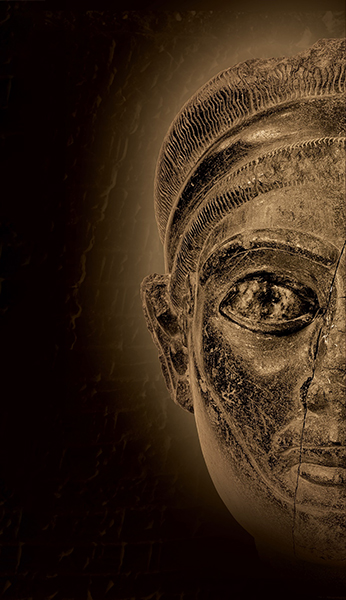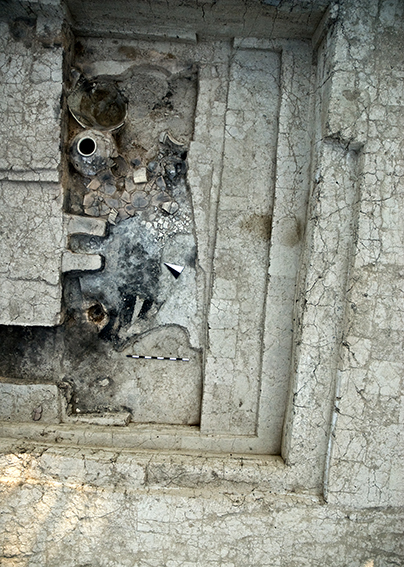MIDDLE BRONZE AGE II (1800-1600 BC)

The urbanized, complex nature of the city during the Middle Bronze is well defined through all excavation areas, revealing the presence of a long-lasting, strong administrative system capable of conducting large-scale building programs from palaces to temples and city fortifications. This is partially defined through deep soundings, providing a glimpse of the arrangement of the space and the city’s public monuments, as well as through archives found in the Level VII palace, which give details about the kings of Alalakh and their relations with other elite members of society and their own overlords (and relatives), the kings of Yamhad who ruled from modern Aleppo, Syria.
The final decades of the Middle Bronze are the best understood part of this period, due to the broad horizontal exposures achieved by Woolley during his excavations of the Level VII palace, temple, and gate complex. This period witnessed the establishment of long distance inland and maritime networks, which are reflected in the increase of foreign elements in material culture coming from Mesopotamia, Egypt, the Aegean, and central Anatolia and in the local adaptation of foreign technological and stylistic approaches and ways of presenting symbolic and ideological values. These early stages of internationalism at Alalakh first appear in Period 7 (Level VII), when both architectural forms and artifact assemblages included the products of long distance trade and political and social interactions. In a number of cases where foreign styles were locally adopted, Alalakh’s royal court seems to have brought artisans and craftsmen with diverse, unique skills from abroad, creating a cosmopolitan production industry.
These industries are revealed both textually and materially. The palace archives detail exchange and shipments of a wide variety of both craft and agricultural products, and the material culture testifies to flourishing bone/ivory and stone industries, manifested in, for example, the whole elephant tusks found in the Level VII palace storerooms and the exquisitely-carved stone bust that likely depicted a king of Alalakh


Alalakh Period 7 was no longer only a provincial agrarian society with inland city characteristics but instead was part of the larger Eastern Mediterranean economy, whose system was never exclusively oriented around agriculture and economic self-sufficiency. The production and circulation of goods and materials defines the vitality of this period. In that respect, the relatively high number of foreign and foreign-imitating artifacts and the technological enhancements observed in Period 7 contexts can be regarded as the harbinger of early internationalism. These artifacts were primarily sponsored and controlled by the royal court.
Signs of complex social, administrative and ritual practices have been found in the fine-tuned stratigraphic excavations within the Royal Precinct area conducted by the new excavations, as well as along the city fortifications along the northeastern slope of the tell. These squares have altered our previous understanding of Late Middle Bronze Age interregional connections from both contextual and chronological perspectives.
The Level IV Palace (LBI) courtyard sounding (Square 32.57) revealed a late MBA temple with an unusual curvilinear wall extension. Furthermore, the Level VII Palace courtyard sounding (Square 33.32) and the Level VII palace southern-wing excavations (Square 33.53) exposed the presence of an earlier monumental palace complex and a cache of recently found fresco fragments in a construction deposit in between these two building phases. Together with wall painting practices, several artifacts including central Anatolian ceramics and Aegean Kamares Ware parallels have been found, effectively reactivating debates regarding the synchronization of distinct regions and chronologies.
Further cross-regional and sequencing data has been acquired through the excavations conducted along the northeastern slope of the tell which exposed MBA fortifications and a cemetery along the exterior slope. The intensity of graves recovered in this area, exceeding 100 individuals, not only highlights the increasing population of Alalakh in the urbanized Middle Bronze but also points to cross-cultural exchange and perhaps to the presence of individuals of non-local origins.
The end of the Middle Bronze Age at Alalakh is marked by the destruction of Level VII in a large-scale fire that burned at least the Royal Precinct. This destruction has often been attributed to the Hittite king Hattušili during his campaigns against Yamhad; Hattušili specifically takes credit for burning Alalakh in texts found at the Hittite capital of Hattuša.


